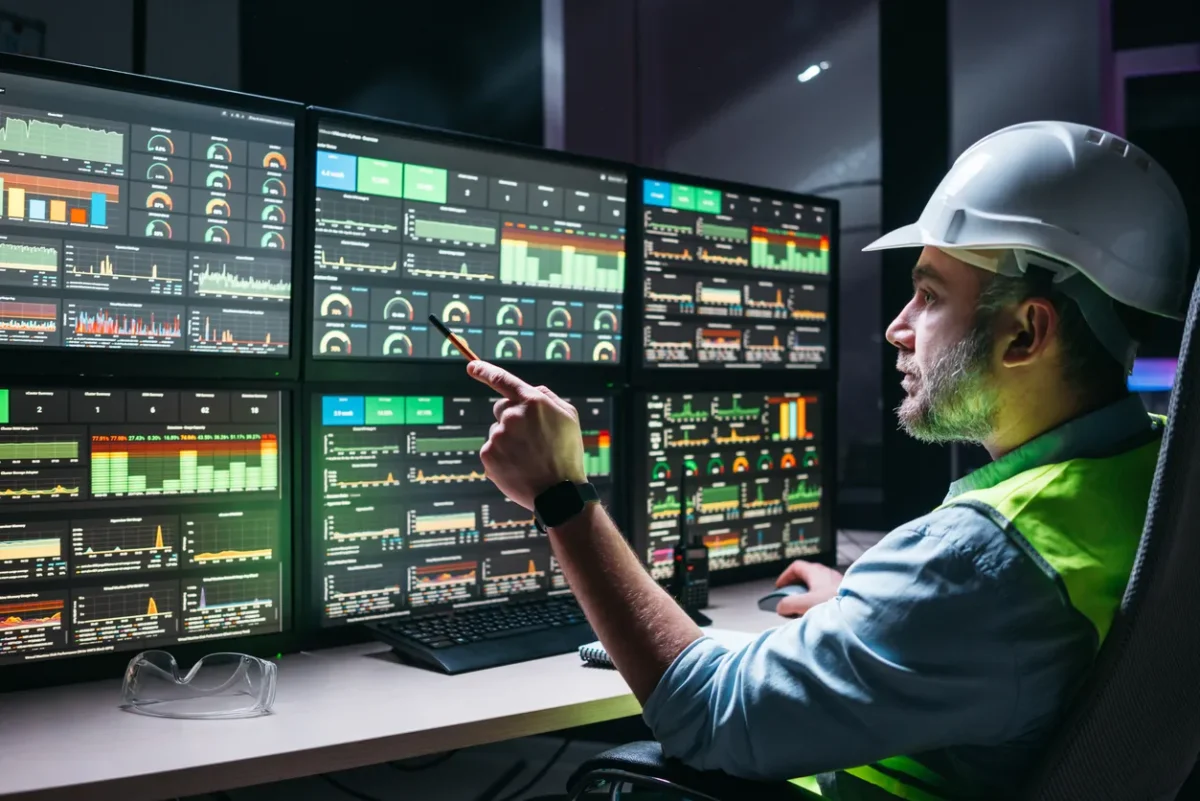As hybrid work has become the norm, facility and asset maintenance leaders are turning to digital twin technology to reduce costs.

As hybrid work has become the norm, facility and asset maintenance leaders are turning to digital twin technology to help them become more cost effective across space planning and asset management, move management, lease management, employee management, and construction management.
But there’s much more to this innovative technology. Digital twins are having a major impact across many areas. Urban planning. Transportation. Biotechnology. Even return to office strategies.
The entire metropolitan city of Shanghai, China, for example, has a digital twin which models 100,000 elements “from refuse disposal and collection facilities to e-bike charging infrastructure, road traffic, and the size and location of apartment buildings,” according to Forbes.
Here’s another example: Tata Consultancy Services used digital twins to serve as a “quantitative aid to explain the current state of the environment and assist in decision-making” for a safe, effective return to office.
And because digital twins are models that capture real-world conditions, they help organizations with risk management. Companies can scenario plan, preventing issues early or even before they even happen.
How does a digital twin work? It’s a whole lot more than a 3D model.
Remember that scene in “Iron Man” where Tony Stark is designing and building his powerful, flying armored suit right in front of your eyes with incredible virtual reality 3D models? We’re not there yet, but we’re not far off either. With current digital twin technology, it’s more about what’s underneath the 3D surface that matters.
“Very often, parallels are drawn between digital twins and 3D modeling based on their user interface and visualization,” writes Pragya Sharma for Parametric Architecture. “However, what distinguishes them is the factor of data. While 3D modeling is limited to providing a view of an object, digital twinning provides a view and real-time data of the object. Digital twins go a step further in exploring how various environmental conditions will impact the object over a period of time.”
It’s all about data sources. As smart buildings become more linked together – from passive and active IoT sensors and IoT connected systems, digital twin technology is expected to revolutionize facility management and asset management by merging what is today too often trapped in separate siloes.
It’s the next generation of business intelligence because of the ability to layer in data and interact with visual representations. To put it in more of a workplace context, let’s look at an example from Space IQ by Eptura in a series about digital twins:
“What if you could document that the coffee maker is located in your main kitchen, it was last serviced two months ago, brews an average of four gallons a day, and is one of three other machines at this office? The data contained in this digital snapshot radically alters how you can maintain this single asset.”
It’s what you can do from there that matters. Imagine taking these kinds of insights and applying them to an entire building or portfolio to inform all workplace expenses to more clearly plan the service and life of assets. It makes maintenance a whole lot easier.
Find and eliminate building operations blind spots with digital twins
The true value of a digital twin is seeing and mapping asset use patterns with employee behavior in context. Companies can now find a whole range of blind spots — allowing managers to explore, locate, interact with, and report on it all.
Fully integrated digital twins allow companies to:
- Model short-, mid-, and long-term “what if” scenarios and conditions
- Quickly create and automate trend, threshold, and rule-based actions
- Gain faster time to value from data-informed decisions
- Lower asset costs from better inventory pattern recognition
- Gain longer asset life cycles
- Cut down on energy usage
Within the context of smart buildings and digitally connected commercial real estate portfolios, digital twins help optimize space planning and maintenance decisions faster and better. No more guesswork.
“Digital twins’ ability to provide dynamic real-world data from a virtual model connects physical and virtual environments in a feedback loop, helping everyone from designers to owners make better decisions about assets and operations,” writes Sarah Jones, Redshift editor in her blog post “In an Innovate-or-Die Era, Automation Is Good for Business and the Bottom Line.”
Next-level modeling: From CAM to BIM to digital twins
What comes after computer aided design (CAD) and building information modeling (BIM)?
Digital twins.
CAD and BIM show the physical world. Digital twins can show you the conditions of employees using physical space and can help link them to real estate costs. It connects the employee experience to all the assets in your buildings — and most importantly, to the bottom line.
The ability to visually model the entire workplace so that you can connect the dots between real-world physical assets with real-time and historical data is having a profound effect on operational efficiency.
“The value of real estate has historically been tied to square footage, but what if it was linked to headcount?” asks SpaceIQ by Eptura. “What if the question we asked was: ‘How much does it cost to place one employee in my building? What about 100 employees? Or 250?’”
BIM and CAD cannot answer these questions. They aren’t able to tell you the number of shared desks or building neighborhood zones. And because you can’t use them to assess the impact of a shifting workforce, there isn’t enough contextual information available to decide whether or not to renew a lease.
Digital twins, however, are not a replacement for BIM. They are an advanced function. Digital twin technology renders a virtual 3D map for facility managers to view performance, identify trends, and detect errors in a physical space to meticulous detail. BIM is still incredibly important in facilities operations.
Learn how Eptura updated the Archibus platform to enable building owner-operators to digitize facility operations and analytics.
How are digital twins different than BIM?
BIM diagrams display all the systems and subsystems. Digital twins focus on space. Where BIM focuses on how the building’s constructed, digital twins focus on how people use the space. Builders use BIM during the design-build construction process.
In construction, digital twins activate when the digital systems arrive online. BIM manages the dynamic systems – HVAC, elevators, windows, access control, etc. – that go into a large building project, digital twins are the foundation for its assets and utilization.
“When a 20’ x 16’ space becomes a conference room with full AV capabilities, the digital twin becomes the framework to manage and optimize it,” reflects SpaceIQ in a post about construction.
“From a bird’s eye POV, arguably, the biggest takeaway from digital twin technology is the simplification of communicating complex information,” writes Dr. Jeremy Nunn, founder & director of Workmetrics in a Forbes column. “It automatically unites data from individual systems to help refine companywide processes and support decision-making in context-rich surroundings.”
SpaceIQ details key ways digital twin technology impacts four areas:
-
Space management and asset management
“You can create a rule that stipulates floors shouldn’t exceed 90% occupancy. When the headcount reaches the 85% threshold, the digital twin can generate an alert.”
-
Lease management
“You could set an alert nine months before a property’s lease ends. This advanced notification creates a window of time to consolidate square footage, change your office density, or terminate the lease.”
-
Move management
“Planners can collaborate and provide real-time input instead of exchanging hard-copy drawings and combining the data. You can retrieve an exact count on any floor at a glance. You can then explore different allocation options with a few keystrokes.”
-
Employee management
“A digital twin that interfaces with HR software merges siloed data into one platform. Imagine an automatic push when a person’s employment ends that goes to the space manager, facilities department, and security team. Without this kind of automation, it’s a challenge to distribute this critical information to all the necessary contacts.”
And there’s another one to add to the list:
-
Construction management with ongoing facility maintenance operations
Los Angeles’ Sofi Stadium, which has already hosted a Super Bowl, “has its own digital twin, which models not just the stadium itself but also the 300-acre Hollywood Park campus around it,” per Forbes.
Built during construction, it “collects data in real-time from every area of the park’s operations into a single platform that can be used to answer questions from everybody from event organizers looking to use the space, to maintenance and janitorial operations.”
Remember the bit about simplifying the complex? This digital twin has its own app so users can quickly access the features and functionality they need.
Digital twin adoption and market growth is real.
Verdantix reports increased intent to spend on digital twins. The need for better facilities optimization and more predictive analytics is expanding. Over a third (31%) of organizations plan to invest in it over the next 12 months. Similarly, over a quarter (26%) of organizations are already using predictive analytics with digital twin extensively and one-fifth (20%) are using it to some limited extent.
Gartner expects revenue from digital twin technology to reach $183 billion by 2031. Back in 2019, its analysts found the following key statistic: 75% of companies that had implemented IoT projects were already using digital twinning in practical application.
Learn more about digital twins. Download 2023 Workplace Predictions: 5 Worktech Trends to Watch


